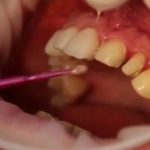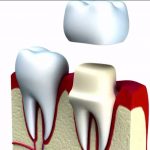Our main objective is to see you smile with confidence, and to achieve this, we offer many cosmetic restoration options. Just two of the treatments we offer are porcelain crowns and veneers. Although both of these improve your smile and appearance, they differ in the way they work, are placed, the preparation, and purpose. So, to help you learn more about veneers and crowns we put together some of the most important aspects that you need to know. In this article here we discuss the similarities and differences about each to help you discover which one might best suit your needs.

Dental Veneers
What are Veneers?

Veneers, also called laminates, are very thin coatings that are cemented to the front surface. They are used to brighten the aesthetics, restore tooth structure, and bring back the function. Compared to fillings, which are directly placed, veneers are considered indirect restorations, meaning they are prepared outside the oral cavity then attached afterward.
Read more about how we can restore your smile with veneers.
Dental Crowns
What are Dental Crowns?

A dental crown is a cap-like structure that is placed over the entire surface of the visible portion of the tooth. They are used to restore facial aesthetics and to rebuild the structure and function of those that are broken or fractured.
Learn how crowns can fix damaged teeth.
Who are the Candidates for Veneers?
Any patient who wants to improve their smile, or get rid of their broken and chipped teeth can be an eligible candidate for veneers. The following are also some of the situations where dentists recommend placing a veneer:
- Staining – Some stains cannot be removed even through professional whitening procedures, like developmental stains. In these cases, veneers are placed over them to hide the aesthetic defect of them.
- Crooked Teeth – Veneers can also be used to restore the shape and structure of crooked or chipped ones. It will work by cosmetically restoring their shape and improve their structure.
- Cosmetic Correction of Diastema – Veneers are the fastest and most cost efficient solution for people suffering from diastema. Diastema is the condition where there is an excessive gap in between them.
- Irregularly Shaped – They can also be corrected by veneers. This cosmetic defect in the shape and alignment can be improved by placing an appropriately shaped and sized veneers.
Who Benefits from Dental Crowns?
Dental crowns are sought for by dentists in correcting the following dental functional problems:
- Extensive Stains – While veneers are used in correcting minor staining, dental crowns are resorted to by dentists on cases when there is already extensive permanent staining This process rests the dental crown over them to hide the extensive staining.
- Fractured Teeth – Dental crowns are also very useful in restoring the shape and structure of those that are badly chipped and broken. On this process, the dental crowns are shaped like a natural tooth, which makes it ideal in bringing back the physical shape that was severely chipped.
- After a Root Canal Treatment – A tooth that has undergone root canal treatment may tend to become brittle and fragile. On which case, dental crowns are used over the tooth to strengthen it and prevent it from chipping.
- Cosmetic Correction of Developmental Anomalies – People suffering from developmental anomalies usually have irregularly sized or shaped ones. On this cases, dental crowns are used to correct the size and shape of these.
- Extensive Fillings – Extensively filled ones are at a higher risk of getting fractured. In which case, dental crowns are used to reinforce them and prevent more significant damage.
How are Veneers Prepared
When it comes to preparation and placement of veneers, the following steps will take place. This process will usually require two dental appointments and each could last for about half an hour.
- Patient Evaluation – A detailed examination will be made before the procedure. In this initial step, one of our dental staff will examine them to evaluate whether or not they are suitable for veneers.
- Tooth Preparation – After evaluation, those that will receive veneers will be prepared for the procedure. On this process, a very thin layer of the natural tooth structure will be removed to give room for the addition of the veneers. In most cases, tooth preparation is carried out without the use of local anesthesia as the tooth surfaced removed is too little to cause sensitivity.
- Impression Making – Then, an impression of will be made. This impression will be sent to the laboratory for the fabrication of veneers. There are cases where doctors opt to give you composite veneers which are prepared at the dental clinic.
- Attaching the Veneer – Once the veneers are made, our expert dentist will first try it on you without cementing them. This process is necessary to evaluate the improvement in your smile and to see if it suit your looks. After having the veneers perfectly tried on, it will be attached permanently by an adhesive cement.
How Dental Crowns are Prepared
The process of creating dental crowns are a bit more complicated compared to dental veneers. Although both of them are usually completed within two dental visits, the steps involved in the preparation of dental crowns are different.
- Patient Evaluation – All patients who need dental crowns need to undergo an extensive clinical examination. This step is an essential considering that the natural tooth that will be removed is thicker compared to veneers. Other than that, the residual thickness of the tooth structure will also be assessed. On this case, if exposure of the pulp is anticipated, local anesthesia is given to prevent you from hurting while the tooth preparation is carried out.
- Tooth Preparation – The process of tooth preparation is carried out almost the same way as how veneers are done. There will be a removal of the natural surface of the tooth. However, placement of dental crowns requires removal of tooth surface all around the tooth unlike veneers where only the front portion has to be removed. Also, the thickness of the portion that have to be removed will depend upon the material that has to be used for the crowns. For instance, a thicker surface is required to be removed for porcelain crowns compared to the metallic material.
- Impression Making – An impression of will made by your dentist. The impression created will be the one that will sent in the laboratory to create the crown.
- Attachment of Crown – Just like attachment in veneers a trial insertion of the crowns will be done to check the fit and appearance. Once the crowns are checked and adjusted it will be cemented with dental cement.
